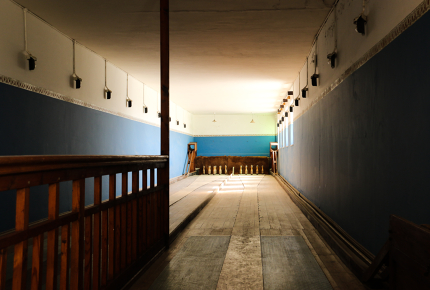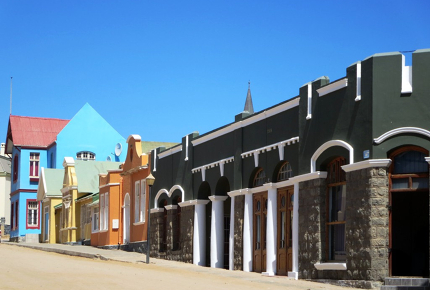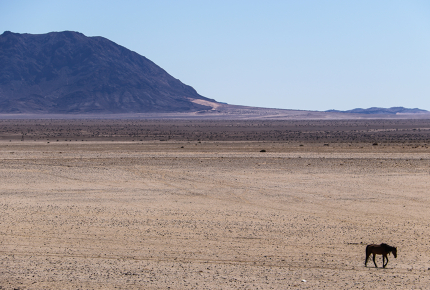Laying the ghosts of Lüderitz to rest
As Namibia’s colonial heritage becomes an increasingly contested battleground, Christopher Clark heads to one of its fading outposts to see what ghosts need to be laid to rest.
Sitting atop a sandy hillock on the outskirts of Kolmanskop, the accountant’s former residence is the biggest and grandest in town, a proud testament to the great diamond wealth that was discovered in this part of Namibia at the turn of the 20th century.
“There were so many diamonds here that people used to tip the waitresses with diamonds instead of cash,” says our guide Juan.
Among other things, this boom town once boasted a casino, a hospital complete with Africa’s first X-ray machine, and the ubiquitous German Kegelhalle (skittle hall).
Today, beyond the few desert plants that continue to grow defiantly in cracked pots on the accountant’s crumbling veranda, and the tracks left in the sand by marauding brown hyenas, it’s hard to imagine anything living in such a desolate and melancholy place.
Indeed, Kolmanskop’s existence was as ephemeral as the supply of precious stones that spawned it. As the diamonds dried up, the thousand or so German settlers who had carved out a strange life of German idyll in the Namib Desert vanished just as quickly as they’d appeared. By the end of WWII, Kolmanskop was a ghost town slowly being swallowed by sand.
Some say the same fate awaits the town of Lüderitz, an incongruously picturesque slice of early 20th century Bavaria - with pastel-coloured art nouveau houses and hilltop Lutheran churches in tow - grafted onto the wild and windswept Skeleton Coast just a few kilometres on from Kolmanskop.
 The ghostly kegelhalle (skittle hall) in Lüderitz
The ghostly kegelhalle (skittle hall) in LüderitzChristopher Clark
As we drive into Lüderitz at dusk on a Saturday evening, the streets are almost deserted. At an unnecessary traffic light, a woman in rags sits in the middle of the road staring at the ground as if our car is the last thing she expects to see.
But beneath the sleepy exterior and creaking colonial grandeur, Lüderitz has become a key battleground in the increasingly fierce feud over Germany’s colonial legacy in Namibia.
Three years ago, the Namibian government made a move to change the town’s name to !Nami#nus, as the area was known to the indigenous Nama before the German tobacco merchant Adolf Lüderitz bought the town from a local chief and named it after himself.
The proposed name change was strongly contested by much of Lüderitz’s white population and the debate came to an uneasy stalemate, but not before it had reopened longstanding divisions stretching back to a genocidal war that left up to 100,000 ethnic Ovaherero and Nama dead at the hands of the Germans.
More than a thousand died in the concentration camp at Shark Island, formerly known as Death Island, a jagged peninsula jutting out into the cold Atlantic just beyond Lüderitz. It is now home to a beachfront self-catering holiday resort.
A couple of neglected monuments on the fringes of the campsite bear tribute to those that perished in the camp. But a memorial commemorating fallen German soldiers dwarfs these monuments.
“It’s still like this all over Namibia,” Juan says.
 Lüderitz is a strange life of German idyll in the Namib Desert
Lüderitz is a strange life of German idyll in the Namib Desert David Stanley
As we wander across the rocks pondering these enduring injustices, a family of Germans camping at the resort sunbathe and play football on the sand below.
At the beginning of June, the German and Namibian governments will finally begin formal negotiations on redress and reparations for the genocide in Namibia, a move that Ovaherero and Nama activist groups have been tirelessly campaigning for over the last decade.
Just a few weeks before the negotiations were announced, thousands of Ovaherero marched through the streets of Swakopmund, Lüderitz’s bigger and more affluent coastal sibling, carrying placards that read, “We are still in chains”, “Remove all Nazi monuments” and “Germans you will pay.”
A famous colonial monument was defaced with red paint during the march.
Back here in Lüderitz, as we sit at Barrel’s Pub eating some of the best crayfish I’ve ever tasted, it’s hard to imagine that either reparations or a change of name will have a significant impact on this fading colonial gem. Slow consumption by the world’s oldest desert is probably still a better bet.
Indeed, driving out of Lüderitz on a road that cuts like a dagger through the heart of the desert, a road sign warns of SAND in capital letters.
The next road sign we pass tells us to look out for wild horses, and a little further on we see a lone stallion walking across the arid plains towards a borehole that was once used to replenish locomotives at the nearby railway line.
It is believed that the ancestors of these wild horses either escaped or were abandoned during the turmoil of the WWI, which eventually saw Germany dispossessed of its colony.
Today, around 150 horses have adapted to the desert environment and manage to eke out an existence here against the odds. They are at once an enduring symbol of this region’s contested colonial history, and its transience in the greater scheme of things.
NEED TO KNOW
Getting there
Kolmanskop and Lüderitz are roughly an 8 hour drive on good tarred roads from Windhoek, Namibia’s capital city. There is also a small airport on the outskirts of Lüderitz, with two Air Namibia flights operating weekly to and from Windhoek.
Where to stay
There are a handful of good backpackers and guesthouses in Lüderitz, most of which are in keeping with the quaint German feel of the town. If the colonial nostalgia gets a little nauseating, head to the modern Protea Sea-View Hotel. Camping and self-catering bungalows are available on Shark Island.
More information
Namibia Experience offers a wide range of guided or self-drive safari itineraries that incorporate Lüderitz and Kolmanskop.
 Wild German horses eke out an existence here against the odds
Wild German horses eke out an existence here against the oddsChristopher Clark
Do you have any Feedback about this page?
© 2026 Columbus Travel Media Ltd. All rights reserved. No part of this site may be reproduced without our written permission, click here for information on Columbus Content Solutions.









 You know where
You know where